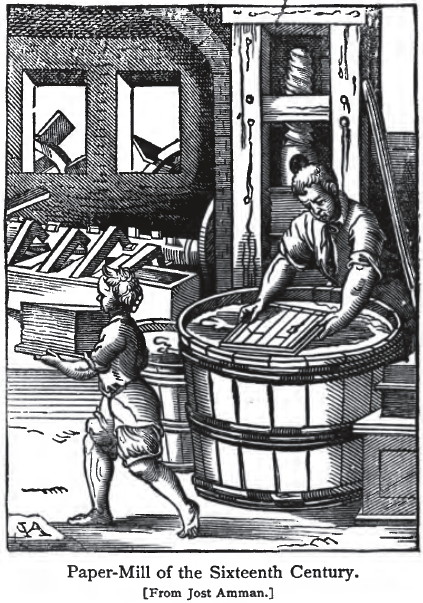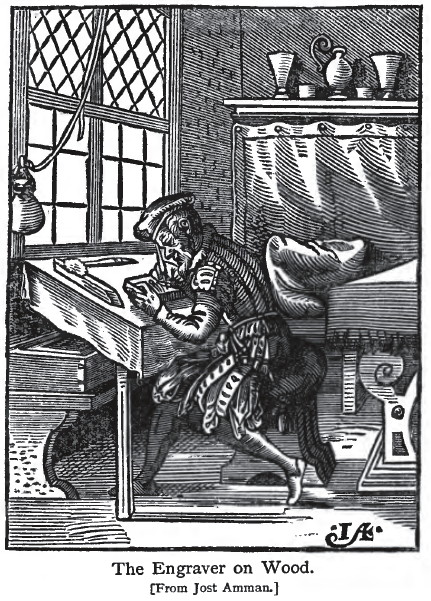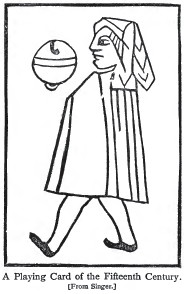Introduction
History of Playing Card Printing
History of board game printing
To a large extent the history of playing card manufacturing reflects the history of illustration printing. Techniques in printing illustrations include:

Xylography, in which the subject is printed from a design engraved on a block of wood in high relief. Wood block printing was used in China aaround 220 C.E. and was common in Europe by the 1300's.
Copper-plate printing, in which the subject is printed from an etching or engraving below the surface of a plate of steel or of copper. Started being used in Europe as early as the 1430's.
Lithography, in which the subject is printed from a transferred engraving on the surface of a prepared stone. It was invented in 1796.
| 16th Century Paper Mill In this illustration (by Jost Amman in his Book of Trades) we see a water mill used for preparing the pulp for paper. Large water-wheels, partially seen through the window, turn a wooden cylinder evenly spiked with projections. As the cylinder revolved, these projections raised, and then dropped heavy stampers of hard wood that beat against the torn and well-soaked rags within the tank. The stamping was continued until the macerated rags were of the consistency of cream. |
 |
| The pulp was then transferred to tubs, where a paper-maker is at work. He dips the pulp out in a thin layer with a hand mould and deckle, the couching of the web on interleaving felts, and it is transfered little boy apprentice to be pressed. The processes of sorting, washing, and bleaching are not shown, but the screw press can be seen behind the paper maker. |
The early playing card industry in Germany may have had a little boost in business from the church. When Pope Boniface IX (1389-1404) extended the grant of indulgences for pilgrimages to locations in addition to Rome, Cologne and Munich, the number of pilgrims increased since they had more options and shorter distances for a pilgrimage to gain remission for their sins. So the demand for printed religious tracts and indulgences also increased. The practice of stenciling the colors on to wood block printed images even gave rise to a German saying: Alle zwolf Apostle auf einen streich machen -To paint all the apostles in one stroke.
Thus, the same printing presses that were supplying sinners with playing cards were often also printing biblical scenes marketed to pilgrims, thus giving a boost to the German printing trade overall, and probably helping it become one of the major producers of playing cards in Europe during the 1400's. It also seems that Germany's the first paper mills started were built in the 1390's. So availability of more inexpensive paper to replace parchment was growing just as cards were spreading across Europe and helped make playing cards affordable to the general public.
| Wood Print Engraver the engraver on wood which appears in Jost Amman's Book of Trades displaus a man in a richer dress, plainly a workman of higher status than the stencil colorer below. The technical accessories about this engraver are the same as those in use at this day the graver, the whetstone, and, possibly, a water globe lens in the corner near the window casement. (Scholars have speculated as to whether this may be a self-portrait of Jost Amman.) |
 |
Although German printers experimented with a wide range of suit signs, cards using the primary traditional German suits of bells, acorns, leaves and hearts can still be found today. The early decks were produced through wood-block printing and then stencils were used to add colors. One of the problems with those symbols was that they needed black outlines and detail lines to make it clear what they represented. Also, many early German cards had little incidental illustrations on every card in the deck, thus all of the cards in a deck needed at least a two-step printing process.
French suit signs appeared about the 1480's, and because they were simple one-color shapes and included no additional illustrations, all the pip cards could printed quickly, with a couple of strokes of a stencil brush instead of having to print the black outlines, wait for the ink to dry, and then stenciling additional colors to fill in the details of every card. Only the 12 face cards in a French deck needed more than one step to be printed. This made French suited cards quicker and cheaper to print.
| Stencil Colorer Jost Amman, in his Book of Trades, portrayed a representation of the print stenciler, as he practised his work in 1564. The method here shown was probably the same method in general use in the 1400's, for coloring of playing cards and other image prints. The illustration includes the bowls that contain different colors, with their brushes, on top of the chest. The colorer is sweeping the brush over the perforated metal plate, and filling up the outlines of the print. |
 |
| Female Card Makers/Painters? Interestingly, "Tax Book of Nuremberg", for the years 1433 and 1435, names Eliza, a card-maker, and for the year 1438, mentions Margaret, a card-painter. The words kartenmacherin, card-maker, and kartenmalerin, card-painter, which are found in these records, do not clearly specify the process, but show that women may have been participating in the manufacture of German cards. Source: The Invention of Printing, Theo. L de Vinne, 1876. |
| Early German Card A facsimile of one of a set of 48 cards in the British Museum. The entire set was found "recycled" as a common use for discarded sheets of cards -as stiffeners in the inner lining of a book cover printed circa 1500. |
 |
| Dull red and dark green were the only colors used in decorating this deck of cards, and were laid on with brush and stencil. |
As a result, during the 1500's France became a major exporter of cards to England as well as various areas of continental Europe. By the 30 Years War (1618-1648) France had even taken over exporting cards to several countries that had previously used German-suited cards probably by virtue of the lower cost of production for French decks, as well as the fact that simpler designs probably made them easier to recognize quickly, especially in a dark tavern, or candle-lit room. This is probably part of the reason why, even today, the French playing card suits remain the international standard for playing cards in most of the world.

The arms of the "Worshipful Company of Makers of Playing Cards" one of the early Trade Guilds in the City of London. Originally founded as the "Mistery of Makers of Playing Cards of the City of London" by a royal Charter granted by King Charles I in 1628. On 27th November 1792 the Court of Aldermen granted the Company its Livery.
Livery Companies developed out of the medieval guilds of London. Guilds originally evolved from a religious base, as craftsmen in specific trades congregated in certain neighborhood parishes and provided mutual aid and protection for their members as well as sponsoring various activities during saints' days, or passion plays. Gradually, economic considerations took over and the guilds main role became the regulation of standards for their craft, including product quality, pricing and the training of apprentices.
Today the the principal activities of the Company today are civic, charitable and social. Their website can be foun at http://www.makersofplayingcards.co.uk/


The illustration below shows a single sheet of face cards and a stencil for coloring the cards. A different stencil was used for each color. At the bottom right is a sorting box to store the cut cards, and help colate the decks.

A close-up of the press and stove for making stiffening past, a mixture of flour and starch.

Your host using a box similar to one pictured above collating our period playing cards on a slow day at the Minnesota Renaissance Festival
